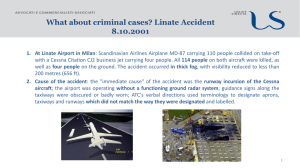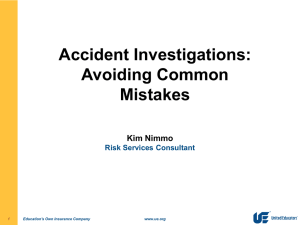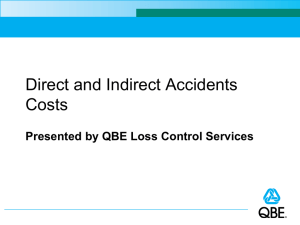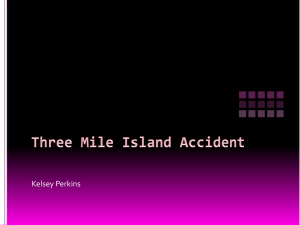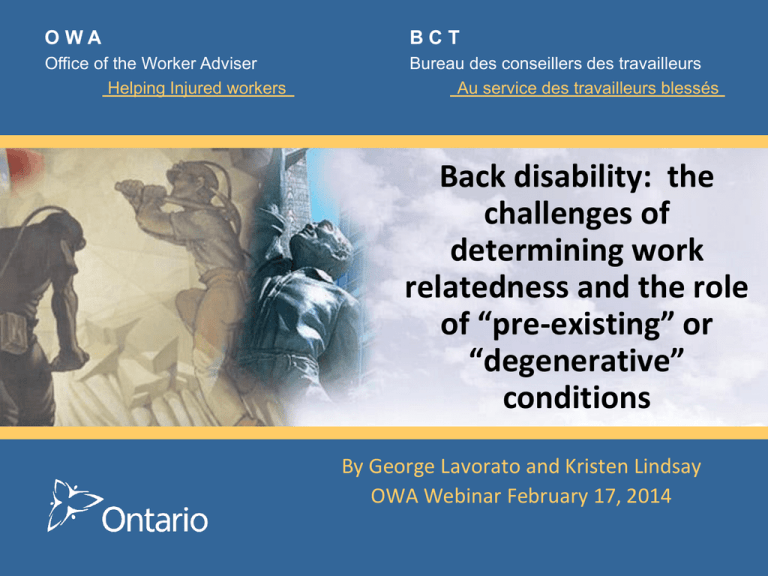
OWA
BCT
Office of the Worker Adviser
Helping Injured workers
Bureau des conseillers des travailleurs
Au service des travailleurs blessés
Back disability: the
challenges of
determining work
relatedness and the role
of “pre-existing” or
“degenerative”
conditions
By George Lavorato and Kristen Lindsay
OWA Webinar February 17, 2014
Areas to be covered
• What are the common types of back
injuries?
• What are “pre-existing conditions”, what is
a “predisposition”, what are “degenerative
conditions”?
• How can factors such as age or gender
legitimately be considered in a no-fault
system based on the Meredith principles?
Unveiling the Medico-Legal Myth of
Degenerative and Pre-Existing Conditions
• What does degeneration mean? The use and abuse of
an ambiguous word, by Richard Wigley, Christopher Walls,
David Brougham, Peter Dixon, The New Zealand Medical
Journal, 27 May 2011
• ACC and back injuries: the relevance of pre-existing
asymptomatic conditions revisited, by Peter A Robertson,
O Ross Nicholson, The New Zealand Medical Journal, 27 May
2011
• Orthopaedic surgeons and their review results and updating of
the knowledge of the pathogenesis of tissue injury, the natural
history of aging and related conditions, to assist with the New
Zealand Accident Compensation System and the application of
the Act on workers with back injuries
Debunking the Myth
• Defining the terms:
Degenerative / Degeneration: they imply an age
relationship and causation because they are loaded words
by definition: changing from a higher to a lower form, i.e., a
less functionally active form
Used to deny compensation entitlement: osteoarthritis
(joints), tendinopathy (tendons), spondylosis (spine)
For radiologists degenerative changes are appearances from
the cumulative effect of minor or major impacts: the
changes are physiological and not just age related
Degenerative changes usually do not cause symptoms and
can be clinically insignificant
Immutable Risk Factors
Age
Predispose
but do not
cause injury
Sex
Accident /
environmental
change =
injury
Genetics
The Spine and Degeneration
• Spine degeneration – loss of disc height,
traction spurs, annular osteophytes
• From chronic overload without symptoms
• There is no explicit definition for
Degenerative Disk Disease
• Spondylosis – a better term because it
does not imply a cause
Spine Degeneration and Risk Factors
• Diffusion of nutrients and oxygen across the
inter-vertebral disc matrix
• Soluble regulators of cell function
• Mechanical load including:
acute, repeated and gradual process injuries
excessive spinal loading or obesity
• Immutable risk factors: age, sex, genetics
• It is important to assess the risk factors in each
case
What is lumbar spondylosis/disc
degeneration?
• Changes in the lumbar spine that show on plain xrays:
• disc space narrowing
• osteophyte or spondylophyte formation
• vertebral end-plate sclerosis
• MRI Scans will show:
• disc desiccation
• annular disruption with disc bulging, disc prolapse,
annular tears, end plate changes
Degenerative Disc Disease or
Asymptomatic?
• These changes are called disc degeneration or
spondylosis and can appear as “pre-existing”
MRI abnormalities
• When there is associated mechanical axial
pain, the term degenerative disc disease
applies; otherwise, the worker is
“asymptomatic”
• Asymptomatic
DDD
Age + Degeneration = Disease?
• The current scientific findings do not support this
equation:
20 years of MR scans demonstrate more abnormalities with
age in asymptomatic people
Yet recent findings show that these changes do not predict
disability: not now or later
• Boos et al: it is the psychological and physical aspects of
related work that predict disability and not MR findings
• Borenstein et al: new low back symptoms not related to
MRI abnormality that predated symptoms/MRI changes
• Jarvik et al: depression a better predictor of low back
pain vs. MRI finding, except with a new disc herniation
The Sum of It
“In essence, these authors showed that
the common aging changes in the lumbar
spine are not predictive of subsequent
pain and disability and therefore the
concept that a person with pre-existing
MRI abnormality would have a likelihood
of going on to develop significant pain
and disability is incorrect.”
In the workers’ compensation context…
• Asymptomatic spondylosis is not a clinical
problem to be addressed because of an
accident
• And it is not “age / degeneration / disease”
that caused the new pain / disability post
accident
• The accident is the whole or substantial cause
of the pain; and otherwise, the spondylosis
would have remained asymptomatic
Pre-existing / Underlying / Degenerative
Spondywhat?
Dysplastic Spondylolisthesis: developmental in intrauterine
phase or early childhood – gradual and developmental and
excluded from coverage
Degenerative Spondylolisthesis: with facet joint arthritis and
to some extent disc degeneration – gradual and symptomatic
and excluded from coverage
Spondylolysis & Isthmic Spondylolisthesis: failure or stress
fracture of the pars interarticularis under flexion; acquired
condition of late adolescence and usually asymptomatic – the
scientific literature does not show those with these
conditions are predisposed to back pain or disability as
adults; they are not gradual processes or part of the aging
process
But are they the cause of the disability?
Spondylolysis
There is no support
in the current
literature that these
conditions are “the
whole or substantial
cause of the
symptoms or
personal injury”
Isthmic
Spondylolisthesis
Work-relatedness & Pre-existing /
Degenerative Conditions
• The most common types of back injuries:
lumbar strain: one time or cumulative lifting
lumbar sprain: one time or cumulative lifting
herniations : loading with or without
twisting
traumatic spine injuries: fractures / bony
disorders / sequestrated disc injury – piece
of disc has broken off
whole body vibration
Proving Causation
History
Medical
Linking
• Accident history
• Medical reporting and history
• Effects of the injury post accident at work , home, medically
• Compatibility of the diagnosis to the accident history
• Is there medical evidence of a pre-existing impairment or condition
• Is the pre-existing condition asymptomatic or symptomatic (treatment and impact on
ability to work within one to two years of the accident)
• If there is evidence of an asymptomatic pre-existing condition or a related impairment,
does the evidence support post accident deterioration
• Obtain a medical opinion in instances where there is a concern raised about a preexisting condition or impairment and obtain clarification on the severity of the accident
• Assess relevant policies: initial and recurrence entitlement, permanent impairments,
including the rating process for permanent impairments in the event of pre-existing
impairments / pre-existing conditions
• Obtain and review previous WSIB claim files;
Significant Contribution
• Excellent application / descriptoin of the significant
contribution test in WCAT Decision 72, 1986
• Since then it has appeared in over 1600 decisions in
Ontario
• The test asks if the work activities significantly
contributed to the development of the condition
• When the evidence for or against is equal, the case is
resolved in the worker’s favour
• The accident does not have to be the sole cause or
even the major cause
But what if there are multiple causes?
• Thin Skull Doctrine: the employer takes the worker
as they find them; the susceptibility to injury from a
pre-existing condition is not relevant; and,
compensation ought to be provided if the pre-existing
condition increases the severity of the injury
• Crumbling Skull Doctrine: workers with pre-existing
impairments are compensated until they return to the
pre-accident state (i.e., aggravation basis
entitlement); and, does the medical evidence show
that the accident advanced the pre-accident
impairment
Pre-existing Condition vs. Impairment
• So far there is no Ontario WSIB policy on pre-existing
conditions
• Introduction in 2005 of an aggravation basis policy
that provides the adjudicative distinction between
these two conditions (Thin Skull / Crumbling Skull):
Pre-existing condition is an
underlying or asymptomatic
condition that did not require
regular medical treatment or
disrupt employment before the
accident
Pre-existing impairment is a
condition, which has produced
periods of impairment/illness
requiring health care and has
caused a disruption in employment
Ontario WSIB Policy:
Pre-existing condition vs. Impairment
• Second Injury Enhancement Fund Cost Relief Policy:
“If a prior disability caused or contributed to the compensable
accident, or if the period resulting from an accident becomes
prolonged or enhanced due to a pre-existing condition, all or part
of the compensation and health care costs may be transferred
from the accident employer in Schedule 1 to the SIEF.”
• Aggravation Basis Policy:
Pre-existing impairment recognized via allowance on an
aggravation basis
The severity of the accident is determined, and if minor,
entitlement is limited to a return to the pre-accident state
There can be a permanent aggravation of the pre-existing
impairment, even if the accident is minor
Possible Policy Changes in Ontario
• As a result of the release of KPMG’s Value for Money
Audit in 2011, Jim Thomas, Independent Chair,
provided a report to the WSIB on the benefits policy
review consultation process:
Pre-existing conditions policy
Recurrences, in relation to pre-existing conditions
Permanent Impairments, in relation to preexisting conditions
Aggravation basis, in relation to any new policy
regarding pre-existing conditions
Meredith Principles and using age and
gender to deny entitlement?
No fault compensation
Exclusive jurisdiction
Collective liability
Administration by an independent agency
Security of payment
Summary: Science and Reform
• There is no provision within the foundation of the Act
to deny injured workers compensation based on age
or gender
• Any reforms made to policy and any introduction of
new policy on pre-existing conditions ought to reflect
the Meredith principles
• The New Zealand articles provide an exciting
opportunity to bring to the fore the current science on
pre-existing conditions and degeneration that we can
apply to our casework and policy changes
WSIAT Decision Review
• We conducted a review of recent WSIAT decisions to
see what the Tribunal said about the Board’s practice
about pre existing conditions and degeneration
Benefits Policy Review Casebook
• The WSIB created this casebook as a resource for the 2012-13 Benefits
Policy Consultation. It's comprised of a sample of decisions made by the
Workplace Safety and Insurance Appeals Tribunal (WSIAT) which are related
to the four areas of policies included in the Benefits Policy Consultation:
• recurrences
• permanent impairments
• work disruptions and
• aggravation basis
• The casebook does not constitute an exhaustive collection of decisions, nor
does the WSIB represent that these cases are authoritative on the
associated policies.
• Notably many of the decisions deny worker’s appeals.
Benefits Policy Review
Casebook
•
•
•
•
•
•
•
•
Aggravation Basis:
1212/11
1269/11
2501/08
2341/08
652/87
754/99
1592/01
Benefits Policy Review
Casebook
• Permanent Impairments:
• 2151/10
• 1251/06
Benefits Policy Review
Casebook
•
•
•
•
•
Recurrences:
64/89
183/07
2089/01
603/12
• These will be stored on the SharePoint site , Casework
Tools. The link is as follows:
• https://intra.sse.gov.on.ca/sites/mol/OWA/Worker%2
0Adviser%20Resources/Forms/AllItems.aspx
DDD and Heavy Work
• DECISION 2264/13 (MacAdam, Young, Broadbent –
January 14, 2014)
• DECISION 1858/12 (Goldberg – November 7, 2012)
• DECISION 2341/08 (Moore – Sept. 17, 2009)
• “…the essential requirement for entitlement for an
aggravation injury is that there be evidence that a
workplace injuring process has, in a material way,
advanced the pathology of the pre-existing
condition.”
Symptomatic Vs. Asymptomatic
• Definition of “pre-accident impairment” in OPM
Document #11-01-05 notes: “(Although the period of
time cannot be defined, a decision-maker may use a
one to two year timeframe as a guide.)”
• DECISION 260/11 (MacAdam-Trudeau-Crocker – April 7, 2011)
• DECISION 2300/06 (Parmar – Wheeler – Crocker – November 30,
2006)
• DECISION 1212/11 (M. Smith – June 27, 2011)
Did The Accident Generate A Permanent Impairment?
• DECISION 789/13
(Kalvin – May 3, 2013)
• DECISION 1122/13 (Lang-Christie-Signoroni
- October 16, 2013)
• DECISION 1242/09 (McLellan – June 26, 2009)
The NEL Reduction Cases
• As per 18-05-05, if the pre-existing impairment is not
measurable, the WSIB rates the total area's impairment, and
reduces this rating according to the significance of the preexisting impairment (see pre-accident disabilty in 14-05-03,
Second Injury and Enhancement Fund).
if minor, there is no reduction
if moderate, there is a 25% reduction
if major, there is a 50% reduction.
• DECISION 1350/13 (McLellan – August, 22, 2013)
• DECISION 204/14 (Netten – February 12, 2014)
• DECISION 1970/13 (McKenzie, Trudeau, Gillies – February 25, 2014)
SIEF Cases
• DECISION 766/13 (Nairn - August 7, 2013)
• DECISION 197/12 (McCutcheon – September 27,
2012)





